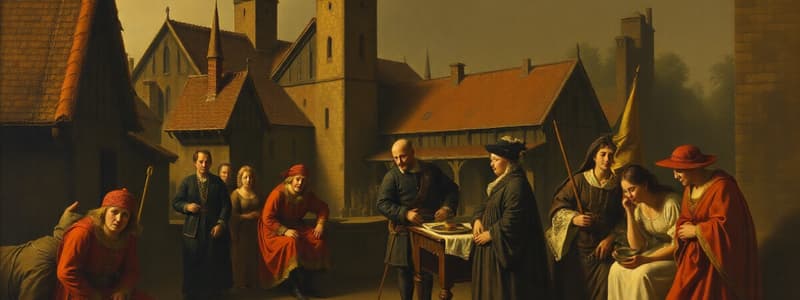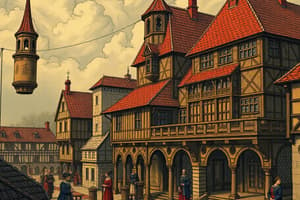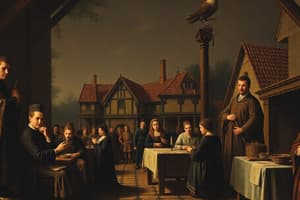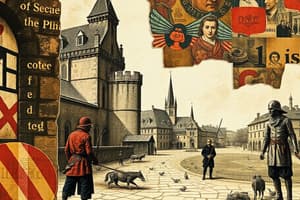Podcast
Questions and Answers
What was the primary role of the Bishop in the feudal system?
What was the primary role of the Bishop in the feudal system?
- To lead military campaigns for the king
- To provide land to the knights
- To manage the treasury of the kingdom
- To oversee the spiritual needs and administration of a diocese (correct)
Which statement accurately describes the relationship between a Baron and their fief?
Which statement accurately describes the relationship between a Baron and their fief?
- Barons were not allowed to divide their fief amongst others.
- Barons divided their fiefs among lords who served the king. (correct)
- Barons managed their fiefs without any obligation to the king.
- Barons relied solely on serfs for defense of their fiefs.
What percentage of what each person produced was given as a tithe to the church?
What percentage of what each person produced was given as a tithe to the church?
- 15%
- 10% (correct)
- 5%
- 20%
How were serfs typically viewed within the feudal system?
How were serfs typically viewed within the feudal system?
What was the main responsibility of lords in the feudal hierarchy?
What was the main responsibility of lords in the feudal hierarchy?
What role did the king play in the feudal system?
What role did the king play in the feudal system?
What was a fief within the feudal system?
What was a fief within the feudal system?
Which statement best describes the lifestyle of serfs in the feudal system?
Which statement best describes the lifestyle of serfs in the feudal system?
How did the Church gain financial support during the feudal era?
How did the Church gain financial support during the feudal era?
What was the typical life expectancy for a serf during the feudal period?
What was the typical life expectancy for a serf during the feudal period?
Flashcards are hidden until you start studying
Study Notes
Feudalism in Medieval Europe
- Feudalism was the dominant social and political structure in Europe during the Middle Ages.
- It lasted for approximately 1,000 years, from the fall of the Roman Empire (476 AD) to the mid-14th century.
Social Hierarchy
- The Church: Bishops were the highest-ranking church officials within a kingdom. Their jurisdiction was known as a diocese. The Catholic Church held immense power during this era.
- The Church received a tithe (a tax) of 10% of all goods produced in the kingdom to support the church and its clergy.
- The King: The highest authority in the land.
- The king granted land (fiefs) to Barons and high-ranking nobles in exchange for their loyalty and military service.
- The Barons: Ruled over large landholdings called fiefs.
- They further divided their fiefs among Lords.
- The Lords: Served the king, some were also knights.
- They paid taxes to the king and provided soldiers.
- They resided in manors (large castles or houses) surrounded by villages containing a church and surrounding farms.
- The Serfs: Peasants who worked the land for the Lords.
- In return, the Lord was responsible for their safety.
- The Lords owned everything on their land, including the serfs, who essentially functioned as slaves.
- Approximately 90% of the population during this period were serfs.
- Some serfs were free and owned businesses, like carpenters, bakers, and blacksmiths.
- Life expectancy for a serf was less than 30 years.
Feudalism
- A social structure and style of government prevailing in Europe during the Middle Ages (476 - mid 14th century).
- Characterized by a hierarchical system where land ownership and loyalty determined social standing.
Social Hierarchy
- King: The highest authority, ruling over the kingdom. Divided land among Barons and nobles in exchange for loyalty and soldiers.
- Barons: High-ranking nobles who received large tracts of land (fiefs) from the king.
- Lords: Served the king and received land from Barons. Some were also knights.
- Bishops: Highest-ranking church officials with significant influence.
- Serfs: Peasants who worked the land for lords in exchange for protection. Majority of the population (about 90%).
- Free Serfs: Could own businesses and practice trades like carpentry, baking, and blacksmithing.
- Church: Received a tithe (10% tax) from everyone in the kingdom to support its activities and clergy.
Key Features
- Fief: A large area of land ruled by a Baron.
- Manor: A large house or castle where the lord resided, surrounded by a village, church, and farmland.
- Serfdom: A system where peasants were bound to the land, working for the lord and receiving protection in return.
- Life Expectancy: Serfs had a short lifespan, typically less than 30 years.
Studying That Suits You
Use AI to generate personalized quizzes and flashcards to suit your learning preferences.




